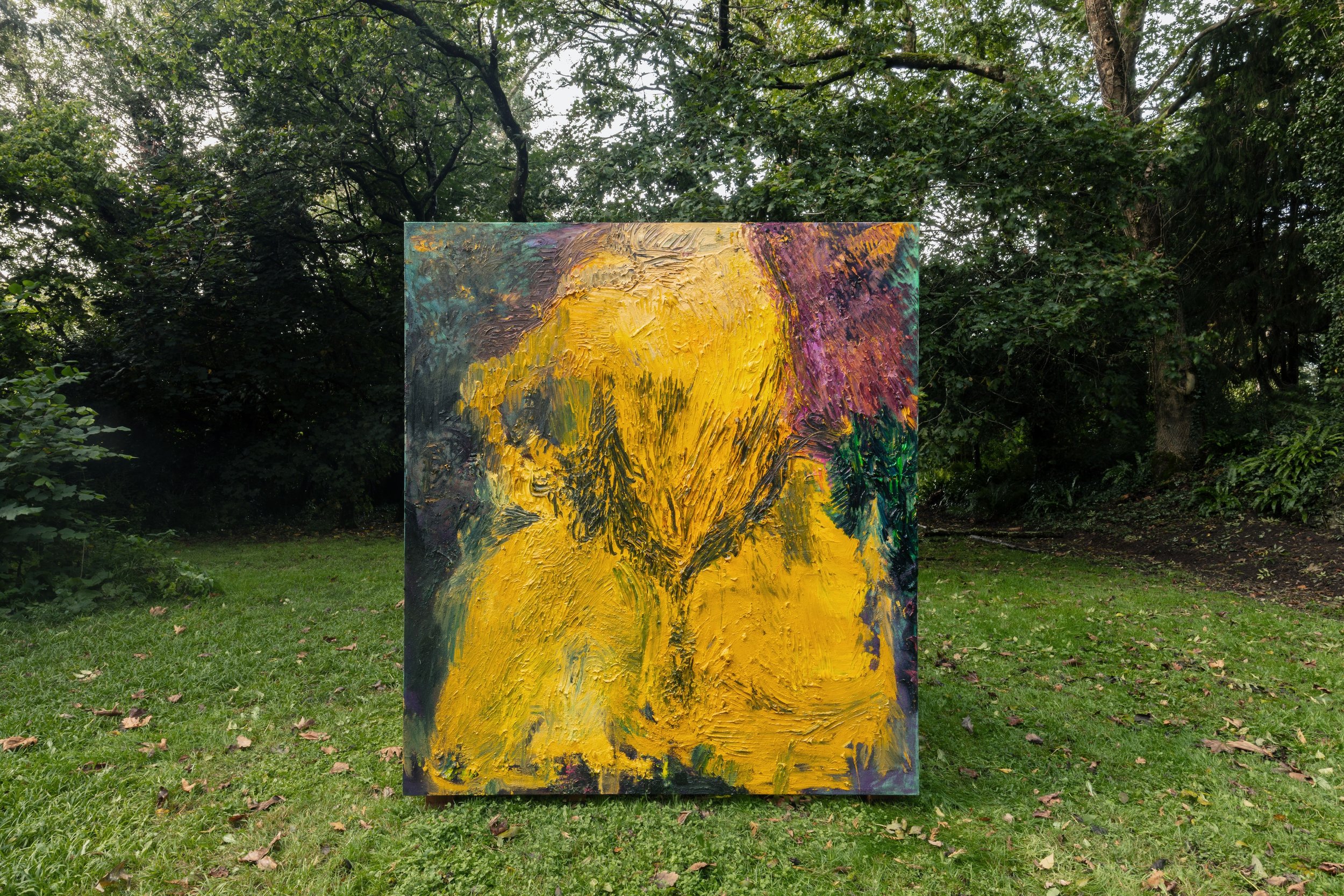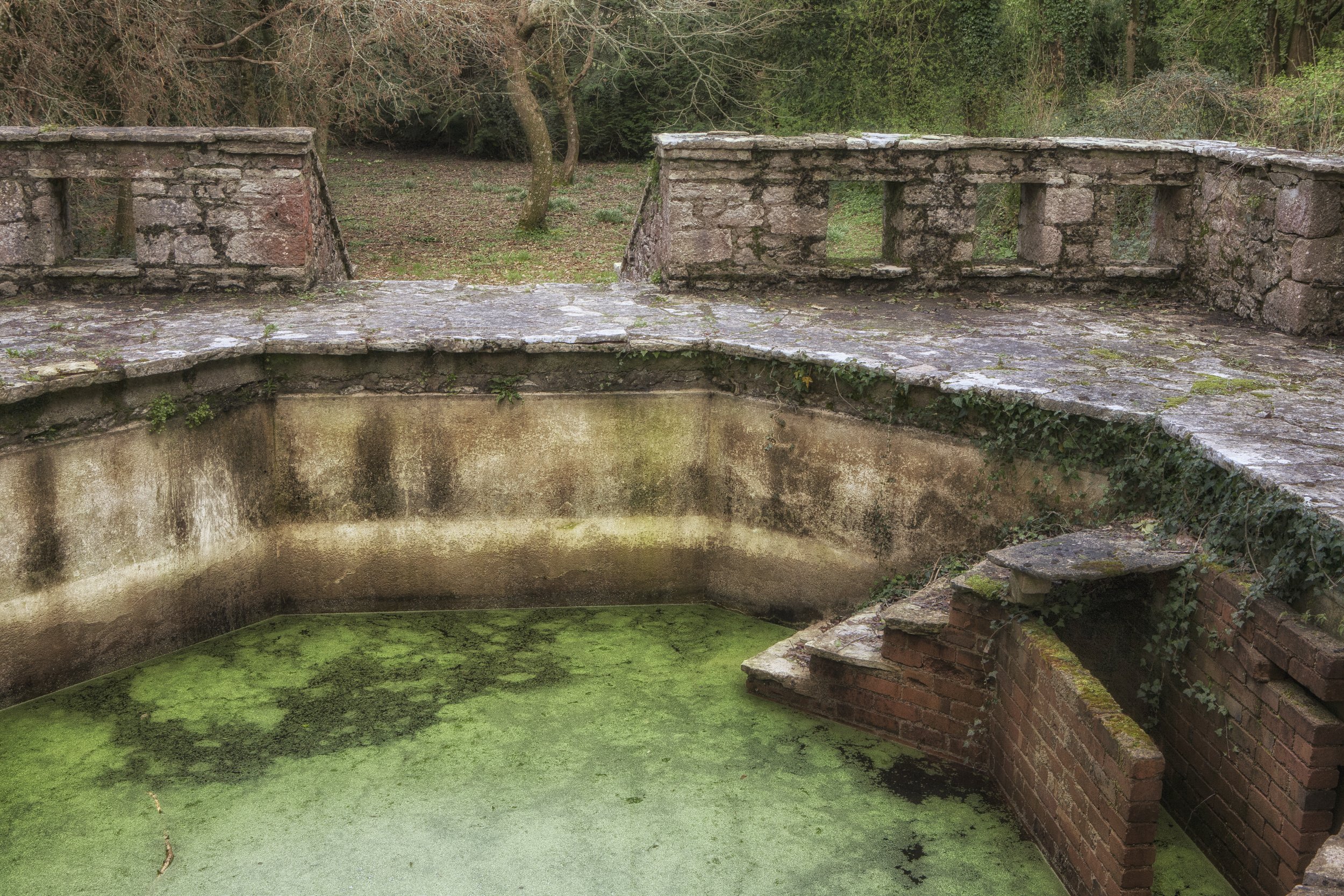In Holes and Corners - James Cabaniuk
In Holes and Corners, a site-specific project by artist James Cabaniuk, supported by literary critic and writer Kate Hext, invites visitors to explore the historical significance of this Edwardian Garden as a private refuge for its curator Arthur Smith Graham, while reflecting on contemporary queer experiences.
Both its owner Graham and architect Thomas Henry Lyon were gay men who lived in an era of criminalised repression. The garden served as a hidden space for personal expression and intimate gatherings. A hanky trail accompanied by Hext's text, will take visitors through the modern story of homoerotic desires and its connection with a sense of fleeting, precious moments. An accompanying soundtrack of queer pop songs re-recorded as siren songs made in collaboration with Georgie Wells will play from the Dell.
Through paintings containing soil from the garden and mixed-media installation integrated into the fabric of the garden, In Holes and Corners, weaves together past and present queer narratives, exploring themes of privacy, identity and the fluidity of self-revelation. The exhibition invites visitors to contemplate how LGBTQ+ communities experience time and space differently, considering how Graham’s original vision of the garden as private retreat transforms when open to the public today.
The exhibition will be accompanied by a series of tours on 25 September, given by James and the noted critic and writer Kate Hext. A twilight tour will be followed by dinner in the Music Hall, the extension designed by Lyon as a performance space attached to Graham's home, Great Ambrook. The exhibition will then be open by appointment only from 26 – 27 September.
Queer artists and writers were electrified into a new consciousness in the late nineteenth century. The causes were various, including unprecedented scientific research into sexual behaviour, and the beginnings of consumer culture. But - essentially - it was the Labouchere Amendment of 1885, which defined 'gross indecency between males' as criminal for the first time, that created a new - often terrifying - sense of personal identity and otherness among men who desired other men. So what were the effects? The facts are easiest to pinpoint: this law remained in place until 1967, during which period prison sentences could be 10 years hard labour. It did not legislate on relationships between women. Men found 'guilty' could be imprisoned or ordered to undertake chemical castration, with the Enigma Code cracker Alan Turing the most famous victim of this penalty in 1952.
And yet, it's not only the historical facts and lost lives that haunt us. It's the way that refiguring same-sex desire as criminal, brought about a new sensibility, a self-conscious of self as other: unspeakable and secret when the Labouchere Amendment was in place. Oscar Wilde referred to eros between men as the love that dare not speak its name', but others in the period created derogatory terms instead: 'abnormal', 'queer', 'poufta', 'pansy', 'invert', 'fairy', 'camp'.
An intense consciousness of being here now defines queer time and space, as it - sometimes defiantly, most often secretly and hesitatingly - emerged in response to such alienating language. Queer time defies the past and disobeys the logic of a ready-made future. It is sensual, imaginative, and immediate, felt on the nerves as a moment of risk and opportunism, of shared unspoken pleasures, and the bittersweet knowledge that it may not last. It makes new intellectual and emotional connections across history and continents, linking queer thinkers, writers, musicians, and artists from the past, present, and future. It is formed just around the corner away from scrutiny where ti might become a sense of freedom; empathy and desire in a whirlwind. All carried off with a wink and a smile.
~ Kate Hext, Great Ambrook, September 2024
The Hanky Trail….
Leading you round the garden, handkerchiefs (used as signals for sexual desire popularised by the gay community), indicated chapters of a scroll written by Kate Hext.
Between 1909 and 1912 Arthur Graham’s Italian Garden was built by the architect Thomas Henry Lyon. Gardens are sites of labour, planning, plotting, and failure and Great Ambrook is no exception. Yet, Lyon designed this garden to be a fantasy space that felt, perhaps, more real than the workaday world outside, or at least more intensely vivid. It is laid out as a walk – a promenade – a spiral – a caprice -- in which to lose your public face and live in the moment.
“We have an interval, and then our place knows us no more. Some spend this interval in listlessness, some in high passions, the wisest, at least among ‘the children of this world,’ in art and song… For art comes to you proposing frankly to give nothing but the highest quality to your moments as they pass, and simply for those moments’ sake”.
~ Walter Pater, Studies in the History of the Renaissance (1873)
In the 1890s, deep sunflower yellow was derided in the conservative press as the colour of disease (‘yellow fever’), naughtiness (with racy French novels published in yellow covers), and cosmopolitan influences (via the art of Henri Toulouse-Lautrec and Edgar Degas). Reclaimed by the decadent movement in London, it became a statement of indifference to polite opinion and a commitment to pleasure à la Pater, ‘simply for those moments’ sake.’
This terrace is a stage set for pleasure and performance. We know little about who came here in Arthur Graham’s time. His close friend, the poet Sholto Osborne Gordon Douglas was though a frequent visitor. The nature of their relationship is one of history’s silences, but Frederick Rolfe’s roman à clef, Nicholas Crabbe (c. 1903), depicts Graham and Douglas in a homoerotic friendship. Imagine Douglas reciting one of his poems here:
This is the hour when all the world’s a-flower
With lilt of life and laughing roses:
This is the day when dancing shadows play
Under the light that Lover discloses.
~ Sholto O. G. Douglas, ‘XIV Now’ in Dawn Without Daylight (1926)
Sissy Force - oil paint, spray paint, pigment, glitter and soil from the Italian Garden
Down under the pergola… Its design fuses classical Italian influences with the bold contemporary proportions and simplicity of Arts and Crafts-style design. Such a fusion of styles and eras is a feature of this garden. The camellias that climb the pergola may have been imported by Graham from Lake Maggiore. Exotic, bright, pungent flowers including camellias, orchids, patchoulis, and hydrangeas, were audacious statements of un-English values. It was not though naturally-grown flowers that became symbolic of queer identity in Graham’s lifetime, but green carnations. Walking along the Left Bank, in Paris, gay men signalled their sexual availability by sporting a green carnation: a cream flower dipped in synthetic green dye. It symbolized (and aimed to reclaim) the nineteenth-century ideology that desire between men is ‘against nature.’ Oscar Wilde, along with several of his friends, wore a green carnation to the opening night of his play, Lady Windermere’s Fan (1892).
Ring In - oil paint, spray paint, pigment, glitter and soil from the Italian Garden
An Italian garden often plays games, springing surprises around corners to delight its visitors, but rarely like this… Usually, in an early-twentieth century ornamental garden, the only water features are rills and fountains. The roman bath, with posts for a peristyle around seating alludes to the gymnasia of ancient Greece, in which baths were places of exhibitionism and voyeurism. For the writer and gay rights activist, John Addington Symonds, gymnasia were homoerotic spaces in which, as he wrote in A Problem in Greek Ethics (1883), ‘lovers enjoyed the greatest freedom.’ Symonds was one of many queer writers and artists in the late-nineteenth and early-twentieth centuries who looked back to the ancient world for a model of how desire between man could be integral to civilized culture.
The plunge pool, like the bath, was a place to see and be seen in the Greek and Roman gymnasium. In Nicholas Crabbe’s depiction of the relationship between Arthur Graham and Sholto Osborne Gordon Douglas, Douglas first appears when he is picked up by the title character, swimming in the Serpentine, in Hyde Park:
“A tiny form like a flash of pearl-coloured flame … descended: and disappeared in the water; and a shining head moved toward the opposite shore… It was so very small, and as insistently pallid as a moonstone on silver… As he came out of the water, Crabbe noted the extremely pure diaphanous whiteness of his skin, the whiteness of his hair – the one warm as living ivory, gleaming, fire-concealing, the other cold as snow, glittering, water-waving”.
~ Frederick Rolfe, Nicholas Crabbe (c. 1903)
Notice Rolfe’s attention to colour here. The man’s effect on him is intense, beautiful and slips out between the cracks of definitive terms and descriptions.
A garden – of any size, any design – can be a sanctuary. Alone or in select company, it is a carved out of the pressing realities and expectations of the lives we lead and the societies we are part of. Writing during the AIDs epidemic, as he created his own garden at Dungeness, while himself dying of AIDS, Derek Jarman used the garden as a metaphor for queer community:
“We must fight the fears that threaten our garden, for make no mistake ours is the garden of the poets of Will Shakespeare’s sonnets, of Marlowe, Catullus, of Plato, and Wilde, all those who have worked and suffered to keep it watered”. ~ Derek Jarman, 1988, qtd. in My Garden’s Boundaries are the Horizon (2020)
In contrast to the dismissal of his community as ‘unnatural’, Jarman re-presents queer community as organic, cultivated, created by a transhistorical community of writers, artists, and lovers.
Queer writers since the late nineteenth century have often thought about queer lived experience not as a line – a lifespan, defined by the markers of a heterosexual life, including children and the sense of futurity that they bring – but as a dimension in which the life of the subject has a special kinship queer writers and artists through history. André Gide is one such:
“I realized with horror how restricted were the passing hours and that time has only one dimension – a line, I thought – whereas I wanted it deep and wide; as my desires hurried impatiently along it, they inevitably impinged on each other”.
~ André Gide, Fruits of the Earth (1917)
The moment of pleasure, passion, and freedom may have been ephemeral, curtailed by laws and social expectations beyond the real and metaphorical garden, but the sense of its connection with others across time and space enriches and intensifies it, as it passes.
~ Kate Hext, Great Ambrook, September 2024

















